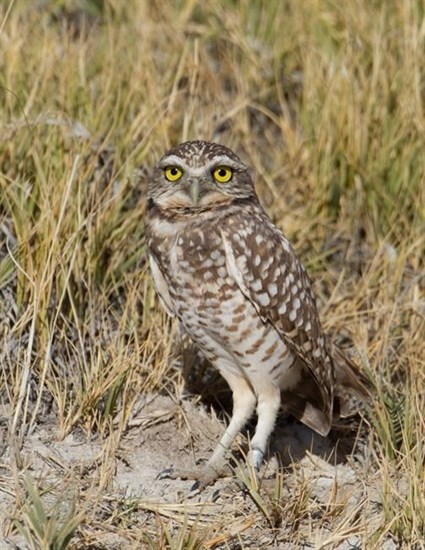
A burrowing owl is shown in a handout photo.
Image Credit: THE CANADIAN PRESS/ho-Ron Dudley
April 08, 2016 - 9:00 PM
MERRITT, B.C. - Burrowing owls will be released on First Nations land for the first time in British Columbia with the goal of reintroducing the endangered yellow-eyed birds on a reserve near Merritt.
Bernadette Manuel of the Upper Nicola Band said three pairs of the pop-can sized brown and white owls will be released into burrows that have been built for them.
"We see it as a responsibility as stewards of the land," she said Friday of the federally funded project the band undertook over two years in partnership with species-at-risk biologists and the Burrowing Owl Conservation Society of BC.
Burrowing owls were traditionally considered guardian spirits to hunters and warriors of the Upper Nicola Band, but Manuel said none have been seen for over a decade.
On Sunday, members of the band will hold a ceremony as six owls are released into a burrow built for them on a reserve, Manuel said. The birds coming to their new home were raised for a year by the society at a site in Kamloops.
Manuel said the First Nation considered eight reserves before finding suitable grassland for the project with the help of the society, which runs a captive breeding program and annually releases burrowing owls in the province's southern Interior.
Biologist Chris Gill, who is working on the project, said burrowing owls live in nests dug by badgers and marmots but when their numbers decreased due to the loss of grassland habitat across the country, the owls started disappearing too.
"Badgers are an endangered species in Canada and because of the declines of badgers there have been less burrows available for burrowing owls."
Gill said "the very charismatic owls" eat insects and rodents but have had dwindling access to prey because of the use of pesticides on agricultural land.
"If these reintroduction programs weren't being undertaken in British Columbia there wouldn't be any breeding owls in B.C."
The Burrowing Owl Conservation Society began a captive breeding program about 26 years ago, said president Mike Mackintosh.
He said members of the First Nation will feed the six owls and a mesh net will be placed on top of their burrow to protect them from predators, such as coyotes, dogs and cats, before they can fly around the grasslands.
Mackintosh said the hope is that the owls will breed this spring before migrating south as far as Mexico and returning in the fall.
"When they fly south we have fairly low returns so that's the big problem we're trying to overcome, the big hurdle," he said.
Last year, 65 burrowing owls were released and had offspring, totalling about 200 birds that were raised successfully in the wild, Mackintosh said.
Sixty of the birds came back to B.C. after migrating south, triple the number from a year earlier, he said, adding it's difficult to determine why there was such a jump in returning owls.
"It could be connected with milder winters and to some degree with climate change. We simply don't know at this point."
News from © The Canadian Press, 2016